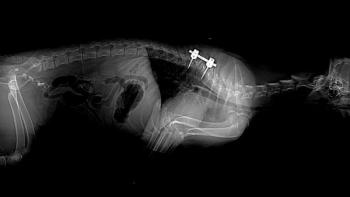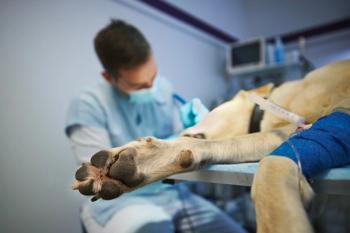
Cranial nerve disorders (Proceedings)
The cavernous sinus is a venous structure that lies on the floor of the skull and encircles the pituitary.
1."Diseases" of CN III, IV, VI, and sympathetic to eye
a. Cavernous Sinus Syndrome
b. Idiopathic Horner's Syndrome
2. Trigeminal nerve diseases
a.Idiopathic Trigeminal Neuritis
b. Trigeminal nerve tumors
3. Facial nerve diseases
a. Idiopathic Facial Nerve Paralysis
b. Hemifacial Spasm
c. Neurogenic KCS
4. Vestibulo-cochlear nerve diseases
a. Idiopathic Vestibular Syndrome (Old dog vestibular syndrome)
b. Congenital Vestibular Syndrome
c. Bilateral Vestibular Syndrome
5. Diseases of Cranial Nerve IX and X
a. Laryngeal paralysis
b. Dysphagias
Cavernous Sinus Syndrome
The cavernous sinus is a venous structure that lies on the floor of the skull and encircles the pituitary. Disease in this area may result in abnormalities of CNs III, IV, VI, the ophthalamic branch of V, as well as sympathetic input to the eye. Causes: neoplasia and granulomatous disease.
Idiopathic Horner's Syndrome
Idiopathic postganglionic Horner's syndrome is seen most commonly in middle aged and older Golden Retrievers and Cocker Spaniels. The cause is unknown, but speculation exists for a viral or immune mediated (or both) etiology.
Clinical Signs: Miosis, enophthamus, and/or ptosis
Rule outs: Trauma, any lesion that can affect sympathetic pathway from hypothalamus to cervical cord to ventral neck, middle ear, and eye.
Diagnostics: Differentiating between preganglionic and postganglionic Horner's syndrome is best done 10 or more days after development of symptoms when the iris becomes super sensitive to sympathomimetics. Prepare a 1% solution of phenylephrine (take 5.0 mls of 2.5% phenylephrine (Mydfrin - Alcon) and add it to 7.5 mls of artificial tear to make a total volume of 12.5 mls) and apply one drop to each eye. If the Horner's pupil dilates to or near to the size of the control fellow eye in 20 minutes or less you have post-ganglionic Horner's. If it takes 40 minutes to get a response, or you do not get a response, then you likely have preganglionic Horner's.
Treatment: Most will improve without treatment in 6 to 16 weeks.
Prognosis: Depends on cause, but the signs themselves are not life threatening.
Idiopathic Trigeminal Neuritis (ITN)
Idiopathic Trigeminal Neuritis is characterized by the acute onset of inability to close mouth i.e. jaw paralysis, which results in difficulty eating or drinking and drooling. It occurs commonly in dogs and infrequently in cats, usually in middle to older aged animals. Pathologically, there is a nonsuppurative neuritis (demyelination and axonal loss) affecting primarily the mandibular branch (motor) of the trigeminal nerve. In one retrospective study of 29 dogs with ITN, golden retrievers were over-represented; age, sex, recent vaccination, or seasonal predispositions were not identified.
Clinical Signs: Sensory branches of trigeminal nerve were affected in 35 % of the cases. In that same study, 8 % of cases also had concurrent facial nerve deficits and 8 % had Horner's syndrome, suggesting that other cranial nerves may be affected. Neurogenic atrophy of the masticatory muscles may occur and can lead to trismus on some occasions.
Rule outs: Rabies, Encephalitis, Trauma
Diagnostics: Rule out other causes. In a retrospective study of cerebrospinal fluid (CSF) analysis in 9 dogs with ITN, 8 had abnormal results (mild to moderate elevations in total protein, nucleated cell count, or both). In 7 of these 9 dogs, needle electromyography (EMG) showed positive sharp waves, fibrillation potentials, or both in the masseter or temporalis muscles, confirming axonal injury to the trigeminal nerve.
Treatment: The condition may be immune-mediated but treatment with corticosteroids does not appear to enhance or shorten recovery. Assistance with eating and drinking is often necessary. Feed gruel-consistency dog food (dogs should still have the ability to lap liquids) or insert feeding tube (pharyngostomy, esophagostomy, PEG, etc).
Prognosis: The disease is usually self-limiting with recovery generally occurring in 1-9 weeks. Mean recovery time is about 3 weeks.
Trigeminal Nerve Sheath Tumor and Other Tumors of Trigeminal Nerve
Infiltrating neoplasia (LSA, Leukemias) may involve a branch or the entire nerve. Nerve sheath tumors may arise on the trigeminal nerve. And occasionally tumors (adenocarcinoma) of surrounding tissues may affect the trigeminal nerve. Other cranial nerves (VII) and the sympathetic system may be involved concurrently with any tumor.
Clinical Signs: The most common sign is unilateral wasting of massetter and temporalis muscles
Rule outs: Trauma, neuritis, brain stem lesion. Rarely will masticatory myositis or inflammatory myositis present as unilateral atrophy.
Diagnostics: Most often requires CT or MRI of skull. Muscle biopsy might be helpful in a few cases if masticatory myositis or protozoal myositis are suspected causes of the atrophy.
Treatment: Difficult but some tumors have been surgically resected.
Prognosis: Depends on etiology, but in general, bleak if tumor is present.
Idiopathic Facial Nerve Paralysis
Idiopathic facial nerve paralysis is an acute, unilateral (most common) or bilateral facial paralysis of unknown etiology recognized in dogs and cats (usually 5 years or older). There appears to be an increased incidence in cocker spaniels and possibly in Pembroke welsh corgis, boxers, English setters, and domestic long hair cats.
Clinical Signs: Inability to close eye, move upper lip, or move ear on affected side indicates facial paralysis. Keratitis sicca or reduced tear production may be present if parasympathetic fibers that travel with the facial nerve are affected. Occasionally Horner's syndrome and peripheral vestibular signs may also be present on the affected side.
Rule outs: hypothyroidism, otitis media/interna, trauma, neoplasia.
Diagnostics: NCV not routinely done but may show abnormal conduction velocity. Diagnosis is a "diagnosis of exclusion"--rule out other causes of facial paralysis.
Treatment: Corticosteroids have unknown efficacy; some feel they are beneficial if used in the early stages of the disease.
Prognosis: Improvement occurs in some patients but may take weeks to months. If function does not return, permanent contracture may occur secondary to chronic muscle paralysis and subsequent muscle fibrosis. The contracture may be mistaken for "improvement" or resolution. In some cases, the contracture is confused with hemifacial spasm.
Hemifacial Spasm
Hemifacial spasm is usually caused by a lesion that irritates the facial nerve (trauma or inflammation/infection of the middle ear). But it can also be caused by a brain stem lesion. This uncommon syndrome is characterized by contraction of the facial muscles: upper lip and ear appear retracted. The spasm must be differentiated from facial muscle contracture secondary to denervation (atrophied muscle, fixed in place). Spasm may precede signs of facial paralysis.
Neurogenic KCS (Xeromycteria, denervation hypersensitivity, parasympathetic nose, neurogenic keratoconjunctivitis sicca)
The moisture of the nasal mucosa and external nares of the dog comes from the lateral nasal gland which is supplied by parasympathetic fibers of the facial nerve. Parasympathetic (PS) denervation can result in a dry nasal cavity and nares. Inspissated nasal discharge can be seen.
Clinical Signs: Dry nose.
Rule outs: Otitis media, hypothyroidism
Diagnostics: Clinically, a thorough otoscopic examination should be done to look for evidence of otitis media since some of these cases are associated with otitis media. Radiographic evaluation of the tympanic bullae and the petrous temporal bone should also be done. Schrimer tear testing will help to determine if the lacrimal gland is also involved causing keratoconjunctivitis sicca (KCS). If xeromycteria (dry nose) is associated with KCS, the preganglionic PS fibers proximal to the pterygopalatine ganglion are likely to have been damaged. Some cases will also have xerostomia (dry mouth) which can be difficult to detect.
Treatment: In cases of KCS either known or suspected to be of neurogenic origin, a lacrimongenic modulator such as cyclosporine A is unlikely to have any effect. Oral pilocarpine, a direct-acting PS-mimetic, mimics acetylcholine and may improve the clinical signs. Try 2 % pilocarpine drops at a dose of 2 drops/20 kg q12h on the food. If the dose isn't sufficient, then increase to 3 drops q 12 h. If gastrointestional signs develop then decrease the dose. Vitamin E at 200-400 U/dog PO q12h has also been recommended. Emollients, such as petrolatum, topical vitamin E, or topical omega fatty acids can be applied to external nares.
Geriatric Idiopathic Vestibular Syndrome
This is an acute vestibular syndrome in older dogs of unknown cause. Aged related ischemic changes to the inner ear is a possible cause. There is no evidence of inflammatory disease in affected animals. The criteria for diagnosing it are: 1. Older dog 2. Sudden onset of *peripheral* vestibular signs 3. No detectable cause i.e. no signs of otitis externa/media, ototoxicity, trauma, hypothyroidism, rickettsial disease, etc. 4. Signs resolve over several weeks.
Clinical Signs: Signs appear suddenly and often result in severe dysfunction and inability to stand and walk. Unilateral peripheral vestibular signs dominate: head tilt to affected side; rolling or falling, or leaning to affected side; nystagmus (horizontal or rotary; occasionally vertical); ataxia, sometimes vomiting or nausea. There are no signs of conscious proprioception deficits, weakness, mental depression, or cerebellar signs, i.e. no signs of central (brain stem) disease. In a few days, the affected animal tends to stabilize and improvement continues for several weeks.
Rule outs: otitis media/interna, trauma, neoplasia, hypothyroidism, rickettsial disease.
Diagnostics: Diagnosis based on exclusion of other causes of vestibular dysfunction.
Treatment: Time
Prognosis: Good. Slight to mild residual signs, esp. head tilt.
Note: A similar syndrome occurs in cats of all ages. Cuterebra larvae migration in ear canal to inner ear has been a proposed theory, but the cause is not known as of yet.
Congenital Vestibular Syndrome
Congenital peripheral vestibular disease has been seen in German shepherds, Doberman pinschers, English cocker spaniels, Siamese and Burmese cats. Unilateral and bilateral signs have been seen in beagles and Akitas.
Clinical Signs: Clinical signs include head tilt, ataxia and in some, deafness.
Rule outs: Trauma, otitis interna, ototoxicity
Diagnostics: Diagnosis is based on excluding other causes of vestibular dysfunction.
Treatment: None
Prognosis: Not life threatening, and some cases may compensate.
Bilateral Vestibular Syndrome
Bilateral peripheral vestibular disease with complete loss of function is characterized by symmetrical ataxia and loss of balance of either side, with strength preserved. Postural asymmetry is not present. A characteristic "side-to-side" head movement often accompanies these signs. Abnormal spontaneous nystagmus is not observed. Causes: idiopathic, bilateral otitis interna, bilateral ear mites, bilateral trauma (over zealous ear cleaning)
Clinical Signs: Since there are no obvious vestibular signs such as head tilt and nystagmus to help localize to the vestibular signs, the drunken, ataxic gait reminds most people of cerebellar ataxia. Because there is bilateral destruction of the receptor organs, normal vestibular nystagmus cannot be elicited by head movement or caloric testing.
Rule outs: Cerebellar disease
Diagnostics:
Treatment: Treat underlying cause
Prognosis: Signs may improve some but are often permanent
Cranial Nerve IX and X Diseases
Disease of cranial nerves IX and X result primary in dysphagia and laryngeal/pharyngeal problems.
Laryngeal paralysis occurs without obvious cause in numerous animals. It may be a component of a diffuse peripheral neuropathy. Some have tried to make an association with hypothyroidism but the evidence is tenuous. Laryngeal paralysis occurs as an inherited abnormality in young Bouvier des Flanders, Siberian huskies and Dalmatians.
Dysphagia may be seen with myopathy, peripheral neuropathy, and NMJ disease. Central causes are rarer, but disease involving these cranial nerve nuclei may result in dysphagia. Cricopharyngeal dysphagia may represent a myopathy or neuropathy involving the cricopharyngeal muscle or its innervation.
Newsletter
From exam room tips to practice management insights, get trusted veterinary news delivered straight to your inbox—subscribe to dvm360.





